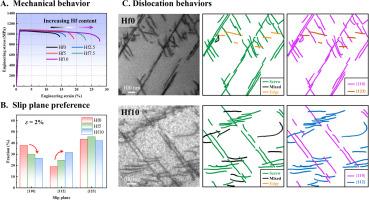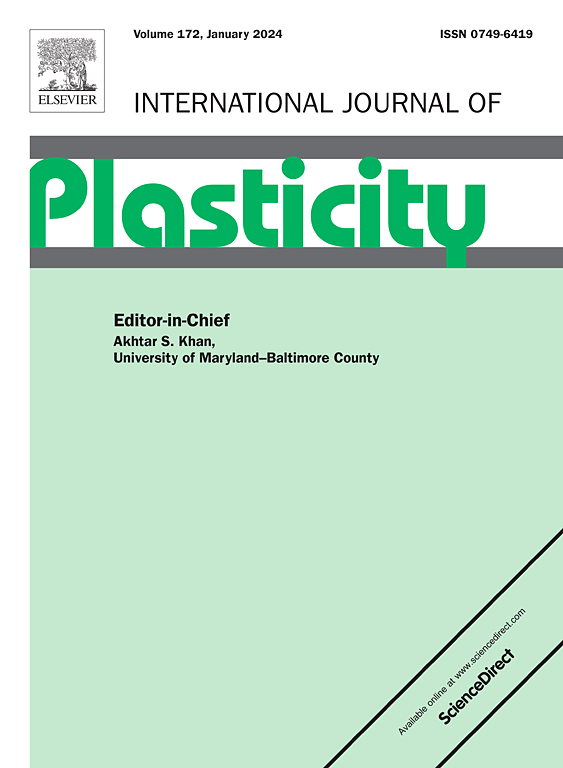Tuning deformation mechanisms in refractory high-entropy alloys: slip plane preference and dislocation behavior
IF 12.8
1区 材料科学
Q1 ENGINEERING, MECHANICAL
引用次数: 0
Abstract
Refractory high-entropy alloys (RHEAs) exhibit exceptional high-temperature strength but typically suffer from limited tensile ductility at room temperature. In this study, we investigate the mechanical properties and underlying deformation mechanisms of single-phase body-centered cubic (BCC) Ti35Zr(35-x)HfxNb20Mo10 (x = 0, 2.5, 5, 7.5, and 10) alloys. Increasing Hf content significantly enhances tensile ductility while maintaining a high yield strength above 1 GPa. Notably, the fracture elongation of Ti35Zr25Hf10Nb20Mo10 alloy is 27.7 %, nearly double that of the Hf-free Ti35Zr35Nb20Mo10 alloy (14.4 %). In-situ electron backscatter diffraction EBSD analysis shows that Hf additions promote the activation of the {112} slip plane, whereas the {123} slip plane is consistently active across all compositions. Transmission electron microscopy (TEM) analysis further reveals distinct dislocation behavior depending on the slip plane: screw dislocations dominate on the {110} plane, while edge and mixed dislocations preferentially glide on high-order planes. These wavy mixed dislocations facilitate cross-slip and the development of secondary planar-slip bands, thereby improving strain uniformity and mitigating local stress concentrations. Moreover, kink bands are observed exclusively in Hf-containing alloys. Their formation is associated with the relaxation of localized strain and stress, contributing to improved fracture resistance. Collectively, these findings offer a detailed understanding of the deformation mechanisms in RHEAs and suggest a promising alloy design strategy to simultaneously enhance strength and ductility—critical for structural applications under extreme thermal and mechanical loading conditions.


难熔高熵合金的调谐变形机制:滑移面偏好和位错行为
耐火高熵合金(RHEAs)具有优异的高温强度,但通常在室温下受到有限的拉伸延展性的影响。在本研究中,我们研究了单相体心立方(BCC) Ti35Zr(35-x)HfxNb20Mo10 (x = 0、2.5、5、7.5和10)合金的力学性能和潜在变形机制。增加Hf含量可显著提高材料的拉伸延展性,同时保持1 GPa以上的高屈服强度。值得注意的是,Ti35Zr25Hf10Nb20Mo10合金的断裂伸长率为27.7%,几乎是不含hf的Ti35Zr35Nb20Mo10合金(14.4%)的两倍。原位电子背散射衍射(EBSD)分析表明,Hf的加入促进了{112}滑移面的活化,而{123}滑移面在所有成分中都保持一致的活性。透射电镜(TEM)分析进一步揭示了滑移面不同的位错行为:螺旋位错在{110}面占主导地位,而边缘位错和混合位错优先在高阶面滑动。这些波状混合位错促进了交叉滑移和二次平面滑移带的发展,从而改善了应变均匀性,减轻了局部应力集中。此外,扭结带只在含氢合金中观察到。它们的形成与局部应变和应力的松弛有关,有助于提高抗断裂能力。总的来说,这些发现提供了对RHEAs变形机制的详细理解,并提出了一种有前途的合金设计策略,可以同时提高强度和延展性,这对于极端热机械载荷条件下的结构应用至关重要。
本文章由计算机程序翻译,如有差异,请以英文原文为准。
求助全文
约1分钟内获得全文
求助全文
来源期刊

International Journal of Plasticity
工程技术-材料科学:综合
CiteScore
15.30
自引率
26.50%
发文量
256
审稿时长
46 days
期刊介绍:
International Journal of Plasticity aims to present original research encompassing all facets of plastic deformation, damage, and fracture behavior in both isotropic and anisotropic solids. This includes exploring the thermodynamics of plasticity and fracture, continuum theory, and macroscopic as well as microscopic phenomena.
Topics of interest span the plastic behavior of single crystals and polycrystalline metals, ceramics, rocks, soils, composites, nanocrystalline and microelectronics materials, shape memory alloys, ferroelectric ceramics, thin films, and polymers. Additionally, the journal covers plasticity aspects of failure and fracture mechanics. Contributions involving significant experimental, numerical, or theoretical advancements that enhance the understanding of the plastic behavior of solids are particularly valued. Papers addressing the modeling of finite nonlinear elastic deformation, bearing similarities to the modeling of plastic deformation, are also welcomed.
 求助内容:
求助内容: 应助结果提醒方式:
应助结果提醒方式:


